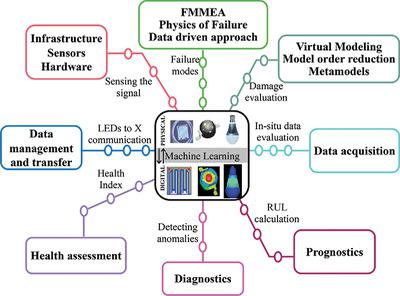当前位置:
X-MOL 学术
›
Laser Photonics Rev.
›
论文详情
Our official English website, www.x-mol.net, welcomes your
feedback! (Note: you will need to create a separate account there.)
Machine Learning and Digital Twin Driven Diagnostics and Prognostics of Light‐Emitting Diodes
Laser & Photonics Reviews ( IF 9.8 ) Pub Date : 2020-10-21 , DOI: 10.1002/lpor.202000254 Mesfin Seid Ibrahim 1, 2 , Jiajie Fan 3, 4, 5 , Winco K. C. Yung 1 , Alexandru Prisacaru 5, 6 , Willem Driel 5, 7 , Xuejun Fan 8 , Guoqi Zhang 5
Laser & Photonics Reviews ( IF 9.8 ) Pub Date : 2020-10-21 , DOI: 10.1002/lpor.202000254 Mesfin Seid Ibrahim 1, 2 , Jiajie Fan 3, 4, 5 , Winco K. C. Yung 1 , Alexandru Prisacaru 5, 6 , Willem Driel 5, 7 , Xuejun Fan 8 , Guoqi Zhang 5
Affiliation

|
Light‐emitting diodes (LEDs) are among the key innovations that have revolutionized the lighting industry, due to their versatility in applications, higher reliability, longer lifetime, and higher efficiency compared with other light sources. The demand for increased lifetime and higher reliability has attracted a significant number of research studies on the prognostics and lifetime estimation of LEDs, ranging from the traditional failure data analysis to the latest degradation modeling and machine learning based approaches over the past couple of years. However, there is a lack of reviews that systematically address the currently evolving machine learning algorithms and methods for fault detection, diagnostics, and lifetime prediction of LEDs. To address those deficiencies, a review on the diagnostic and prognostic methods and algorithms based on machine learning that helps to improve system performance, reliability, and lifetime assessment of LEDs is provided. The fundamental principles, pros and cons of methods including artificial neural networks, principal component analysis, hidden Markov models, support vector machines, and Bayesian networks are presented. Finally, discussion on the prospects of the machine learning implementation from LED packages, components to system level reliability analysis, potential challenges and opportunities, and the future digital twin technology for LEDs lifetime analysis is provided.
中文翻译:

发光二极管的机器学习和数字双驱动诊断和预测
发光二极管(LED)与其他光源相比,具有多功能性,更高的可靠性,更长的使用寿命和更高的效率,是彻底改变照明行业的重要创新之一。在过去的几年中,对延长寿命和提高可靠性的需求吸引了许多有关LED的预测和寿命估计的研究,从传统的故障数据分析到最新的降级建模和基于机器学习的方法。但是,缺乏评论来系统地解决当前不断发展的机器学习算法和方法,以用于LED的故障检测,诊断和寿命预测。为了解决这些缺陷,本文提供了有关基于机器学习的诊断和预后方法及算法的综述,有助于改善LED的系统性能,可靠性和寿命评估。介绍了包括人工神经网络,主成分分析,隐马尔可夫模型,支持向量机和贝叶斯网络在内的方法的基本原理,优缺点。最后,讨论了从LED封装,组件到系统级可靠性分析的机器学习实现的前景,潜在的挑战和机遇,以及用于LED寿命分析的未来数字孪生技术。介绍了方法的优缺点,包括人工神经网络,主成分分析,隐马尔可夫模型,支持向量机和贝叶斯网络。最后,讨论了从LED封装,组件到系统级可靠性分析的机器学习实现的前景,潜在的挑战和机遇,以及用于LED寿命分析的未来数字孪生技术。介绍了方法的优缺点,包括人工神经网络,主成分分析,隐马尔可夫模型,支持向量机和贝叶斯网络。最后,讨论了从LED封装,组件到系统级可靠性分析的机器学习实现的前景,潜在的挑战和机遇,以及用于LED寿命分析的未来数字孪生技术。
更新日期:2020-12-12
中文翻译:

发光二极管的机器学习和数字双驱动诊断和预测
发光二极管(LED)与其他光源相比,具有多功能性,更高的可靠性,更长的使用寿命和更高的效率,是彻底改变照明行业的重要创新之一。在过去的几年中,对延长寿命和提高可靠性的需求吸引了许多有关LED的预测和寿命估计的研究,从传统的故障数据分析到最新的降级建模和基于机器学习的方法。但是,缺乏评论来系统地解决当前不断发展的机器学习算法和方法,以用于LED的故障检测,诊断和寿命预测。为了解决这些缺陷,本文提供了有关基于机器学习的诊断和预后方法及算法的综述,有助于改善LED的系统性能,可靠性和寿命评估。介绍了包括人工神经网络,主成分分析,隐马尔可夫模型,支持向量机和贝叶斯网络在内的方法的基本原理,优缺点。最后,讨论了从LED封装,组件到系统级可靠性分析的机器学习实现的前景,潜在的挑战和机遇,以及用于LED寿命分析的未来数字孪生技术。介绍了方法的优缺点,包括人工神经网络,主成分分析,隐马尔可夫模型,支持向量机和贝叶斯网络。最后,讨论了从LED封装,组件到系统级可靠性分析的机器学习实现的前景,潜在的挑战和机遇,以及用于LED寿命分析的未来数字孪生技术。介绍了方法的优缺点,包括人工神经网络,主成分分析,隐马尔可夫模型,支持向量机和贝叶斯网络。最后,讨论了从LED封装,组件到系统级可靠性分析的机器学习实现的前景,潜在的挑战和机遇,以及用于LED寿命分析的未来数字孪生技术。











































 京公网安备 11010802027423号
京公网安备 11010802027423号